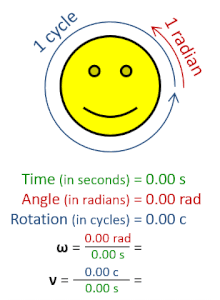Angular frequency
| Angular frequency | |
|---|---|
 | |
Other names | angular speed, angular rate |
Common symbols | ω |
| SI unit | radian per second(rad/s) |
Other units | degrees per second(°/s) |
| InSI base units | s−1 |
Derivations from other quantities | ω=2πrad ⋅ ν,ω=dθ/dt |
| Dimension | |

Inphysics,angular frequency(symbolω), also calledangular speedandangular rate,is ascalarmeasure of theanglerate(the angle per unit time) or thetemporal rate of changeof thephaseargumentof asinusoidal waveformorsine function(for example, in oscillations and waves). Angular frequency (or angular speed) is the magnitude of thepseudovectorquantityangular velocity.[1]
Angular frequency can be obtained multiplyingrotational frequency,ν(or ordinaryfrequency,f) by a fullturn(2πradians):ω= 2πrad⋅ν. It can also be formulated asω= dθ/dt,theinstantaneous rate of changeof theangular displacement,θ,with respect to time,t.[2][3]
Units
[edit]InSIunits,angular frequency is normally presented in the unitradianpersecond.The unithertz(Hz) is dimensionally equivalent, but by convention it is only used for frequencyf,never for angular frequencyω.This convention is used to help avoid the confusion[4]that arises when dealing with quantities such as frequency and angular quantities because the units of measure (such as cycle or radian) are considered to be one and hence may be omitted when expressing quantities in terms of SI units.[5][6]
Indigital signal processing,the frequency may be normalized by thesampling rate,yielding thenormalized frequency.
Examples
[edit]Circular motion
[edit]In a rotating or orbiting object, there is a relation between distance from the axis,,tangential speed,,and the angular frequency of the rotation. During one period,,a body in circular motion travels a distance.This distance is also equal to the circumference of the path traced out by the body,.Setting these two quantities equal, and recalling the link between period and angular frequency we obtain:Circular motion on the unit circle is given by where:
- ωis the angular frequency (SI unit:radians per second),
- Tis theperiod(SI unit:seconds),
- fis theordinary frequency(SI unit:hertz).
Oscillations of a spring
[edit]| Part of a series on |
| Classical mechanics |
|---|
An object attached to a spring canoscillate.If the spring is assumed to be ideal and massless with no damping, then the motion issimple and harmonicwith an angular frequency given by[7] where
- kis thespring constant,
- mis the mass of the object.
ωis referred to as the natural angular frequency (sometimes be denoted asω0).
As the object oscillates, its acceleration can be calculated by wherexis displacement from an equilibrium position.
Using standard frequencyf,this equation would be
LC circuits
[edit]The resonant angular frequency in a seriesLC circuitequals the square root of thereciprocalof the product of thecapacitance(C,with SI unitfarad) and theinductanceof the circuit (L,with SI unithenry):[8]
Adding series resistance (for example, due to the resistance of the wire in a coil) does not change the resonant frequency of the series LC circuit. For a parallel tuned circuit, the above equation is often a useful approximation, but the resonant frequency does depend on the losses of parallel elements.
Terminology
[edit]Although angular frequency is often loosely referred to as frequency, it differs from frequency by a factor of 2π,which potentially leads confusion when the distinction is not made clear.
See also
[edit]- Cycle per second
- Radian per second
- Degree (angle)
- Mean motion
- Rotational frequency
- Simple harmonic motion
References and notes
[edit]- ^ Cummings, Karen; Halliday, David (2007).Understanding physics.New Delhi: John Wiley & Sons, authorized reprint to Wiley – India. pp. 449, 484, 485, 487.ISBN978-81-265-0882-2.(UP1)
- ^"ISO 80000-3:2019 Quantities and units — Part 3: Space and time"(2 ed.).International Organization for Standardization.2019.Retrieved2019-10-23.[1](11 pages)
- ^
Holzner, Steven (2006).Physics for Dummies.Hoboken, New Jersey: Wiley Publishing. pp.201.ISBN978-0-7645-5433-9.
angular frequency.
- ^Lerner, Lawrence S. (1996-01-01).Physics for scientists and engineers.p. 145.ISBN978-0-86720-479-7.
- ^Mohr, J. C.; Phillips, W. D. (2015). "Dimensionless Units in the SI".Metrologia.52(1): 40–47.arXiv:1409.2794.Bibcode:2015Metro..52...40M.doi:10.1088/0026-1394/52/1/40.S2CID3328342.
- ^"SI units need reform to avoid confusion".Editorial.Nature.548(7666): 135. 7 August 2011.doi:10.1038/548135b.PMID28796224.
- ^ Serway, Raymond A.; Jewett, John W. (2006).Principles of physics(4th ed.). Belmont, CA: Brooks / Cole – Thomson Learning. pp. 375, 376, 385, 397.ISBN978-0-534-46479-0.
- ^ Nahvi, Mahmood; Edminister, Joseph (2003).Schaum's outline of theory and problems of electric circuits.McGraw-Hill Companies (McGraw-Hill Professional). pp. 214, 216.ISBN0-07-139307-2.(LC1)
Related Reading:
- Olenick, Richard P.; Apostol, Tom M.; Goodstein, David L. (2007).The Mechanical Universe.New York City: Cambridge University Press. pp. 383–385, 391–395.ISBN978-0-521-71592-8.













